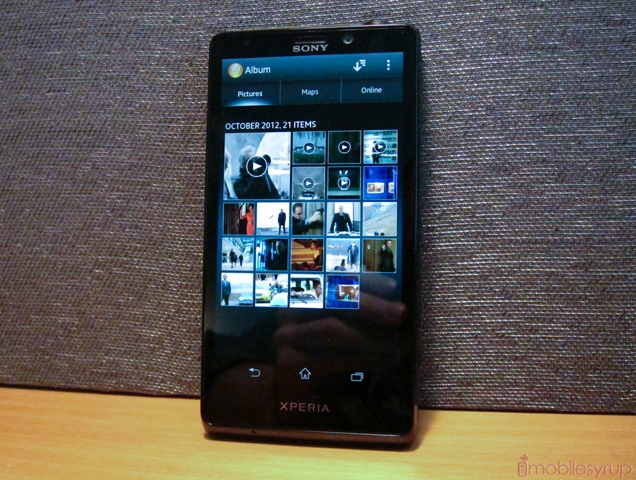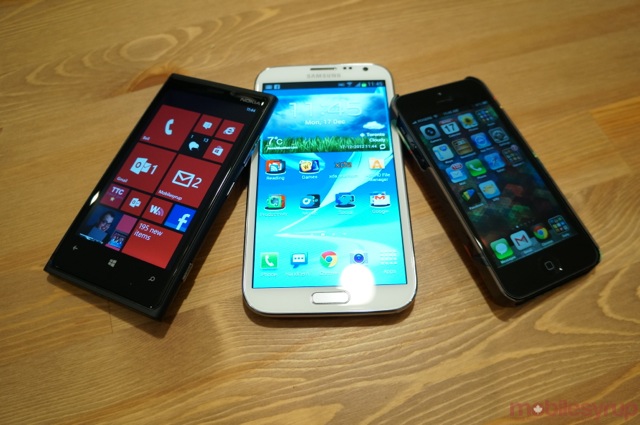
This year has been an incredible year for smartphones, and for smartphone owners. From the rise of Android to the promise of Windows Phone 8 to the evolutionary steadfastness of the iPhone 5, every segment of the population has been properly served.
But there is no smartphone perfect for everyone: some are not released on all carriers; others are prohibitively expensive; many are too heavy or oversized; some have poor battery life. The ideal scenario is to find a smartphone that fits as many personal criteria as possible, and to enjoy what you have. There is always something better on the horizon, and the feverish pace of smartphone advancement means that consumers often feel confused or frustrated by what is out there.
Many of the top manufacturers such as Apple and Samsung have turned to releasing one flagship device per year, while companies like HTC and Sony often accompany their top devices with several cheaper alternatives.
In this round-up, we will proclaim our seven favourite high-end smartphones and our three favourite entry-level devices.
Without further ado, let’s begin:
Smartphones of the Year (High-End)
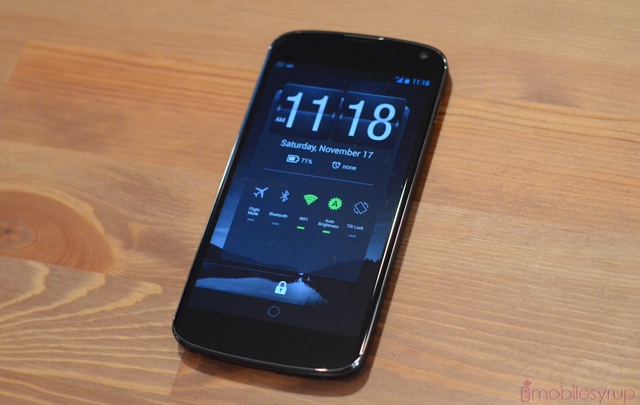
NUMBER ONE – Google Nexus 4
The Nexus 4 is the best Android smartphone currently available, not because it is the fastest or the most well-made, but because it hits a solid 90% or above in almost every category.
Aside from its low price point, which is a huge draw on its own, the Nexus 4 contains a quad-core Qualcomm processor, a gorgeous 4.7-inch HD screen and, for the first time on a Nexus device, a decent camera. It also comes with Android 4.2 out of the box and the promise of much faster updates than Canadians experienced on the carrier-sold Galaxy Nexus.
The Nexus 4 is also the first Google-made phone that competes with its peers on a spec basis; its quad-core Snapdragon S4 Pro chip is one of the fastest on the market, and while the handset is prone to thermal-based throttling, it is subjectively the smoothest Android experience currently available. Google has also done a tremendous job optimizing Android for its current generation of Nexus devices, and the result is an unquestionably mature smartphone.
But just because the device looks good, performs well and stays up to date doesn’t automatically make it the smartphone of the year. It’s Google’s business model that really gets us excited: selling directly to Canadians for $319/$359 for the 8GB and 16GB models respectively provides tremendous value for those uninterested in signing a contract. The Nexus 4 is a gateway drug to anyone accustomed to the largely backwards tradition of signing a contract in exchange for a subsidized phone; the ability to move around to any carrier — and in this case, any GSM carrier in Canada — is a win for consumers.
Add to that the newly-discovered LTE abilities of the Nexus 4 and you have an extremely well-rounded device. We do have some misgivings about the phone, but they’re minor: battery life, even when using baseband-friendly HSPA+ networks, is on the unfortunate side, and there have been some issues with software bugginess that we’re sure Google will solve. The device’s glass back, too, is both a blessing and a curse; though adorned with Gorilla Glass, it is more prone to minor abrasions from regular use than the average plastic or metal competitor.
Stock issues have also affected the Nexus 4’s availability, as manufacturer LG continues to struggle to provide a sufficient number of units for worldwide distribution. Going into the Christmas season, however, it’s clear that Google’s new flagship is not only a victim of its own popularity, but an example of how the smartphone industry is quickly changing from being carrier- to manufacturer-dominated.
The Nexus 4 is available directly from the Google Play Store, starting at $319CDN.
Read more: Nexus 4 Review
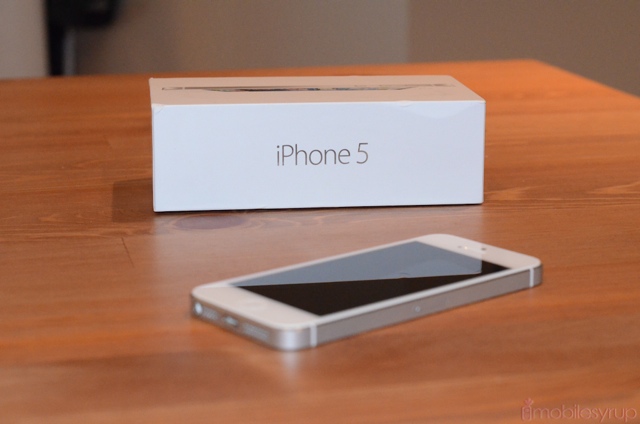
NUMBER TWO – Apple iPhone 5
The iPhone 5 may not have reset the smartphone-maker’s image in the eyes of critics, but for millions of Canadians the phone is exactly what they wanted. Thinner, lighter, faster and smarter, the iPhone 5 has some of the best build quality we’ve ever seen from a smartphone. Its 4-inch screen may not appease the supersized tendencies of various Android users, but Apple has found a screen sweet spot with this particular phone.
Apple’s custom-made A6 chip blows away the competition in terms of raw CPU and GPU power — yes, even your high-end Android superphone — and its camera is still best in class. Despite inroads from Android, iOS 6 is the best ecosystem for developers to make money and users to find great content.
The iPhone 5 is also the first significant redesign in Apple’s lineup since the iPhone 4 in 2010. The understated sleekness of the dual-toned back and sloping aluminum sides are examples of Apple’s emphasis on minor details. And even though the 1136×640 pixel screen is no denser than its iPhone 4/4S predecessor, it is notably less reflective and more colour-accurate.
iOS 6 may look nearly the same as its five previous versions, and Lord knows it needs a visual overhaul, it is still more consistently smooth than any other operating system. Now that Google has graced the ecosystem with its own excellent apps, including Gmail and Google Maps, iPhone users can get the best of both worlds.
The iPhone 5 is available on nearly every major carrier in Canada — Rogers, Fido, TELUS, Bell, Virgin Mobile, MTS, Sasktel — and comes in both black and white.
Read more: iPhone 5 Review
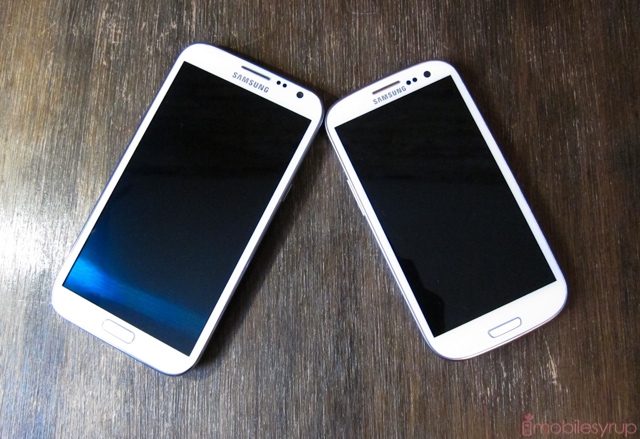
NUMBER THREE: Tie: Samsung Galaxy S III & Samsung Galaxy Note II
Is it unfair to pair these phones as one? Many vocal critics of the Note II will disagree with me here but I think the phablet has a place at the top of this list with its “smaller” kin. The reason they’re together here is because these devices have informed one another throughout their brief lives. The GS3 was quite a departure from its predecessor in terms of design, and while it was criticized early on for being awkward — even ugly — it is has grown on me.
More importantly, 2012 was the year that Samsung won. The company has gone from a bit player to the player in three years, and for the Korean giant to enforce a unified design across every carrier is a huge win for consumers, and for the public’s perception of the Galaxy brand. The devices also launched on AWS-based carriers such as WIND Mobile and Mobilicity, giving the new entrants a couple of hero devices with which to advertise their expanding HSPA+ networks.
That the Note II looks like an oversized Galaxy S III is no mistake. But the two devices have informed one another both in hardware and software; the company’s Nature UX, which debuted on the GS3 running Android 4.0.4, may not be the most functional or attractive Android skin, but its feature set is a mile long. Additions like Smart Stay, AllShare Cast, S Beam and heavy gesture support in ICS gave way to Smart Rotation, Multi View and Blocking Mode in Jelly Bean. And Samsung’s perpetual marketing machine ensures that users are well informed of these features.
The Note II took the S Pen from the original, improved its responsiveness and added a number of excellent features for students, sketchers and business people alike. The company bested the original in nearly every way and, against all perceived odds, has created a viable smartphone category in the Note.
It’s hard to walk down the street these days without seeing at least one Galaxy S III; the brand has become as ubiquitous as the iPhone. Though Samsung has a lot to learn about build quality (no more plastics!) and UI design, there is no mistaking the sheer brute-force success of these two devices.
The Galaxy S III is available from Rogers, TELUS, Bell, Koodo, Fido, Virgin Mobile, WIND Mobile, Mobilicity, SaskTel, Videotron, MTS.
The Galaxy Note II is available from Rogers, TELUS, Bell, WIND Mobile, Mobilicity, SaskTel, Videotron, MTS.
Read more: Galaxy S III Review & Galaxy Note II Review
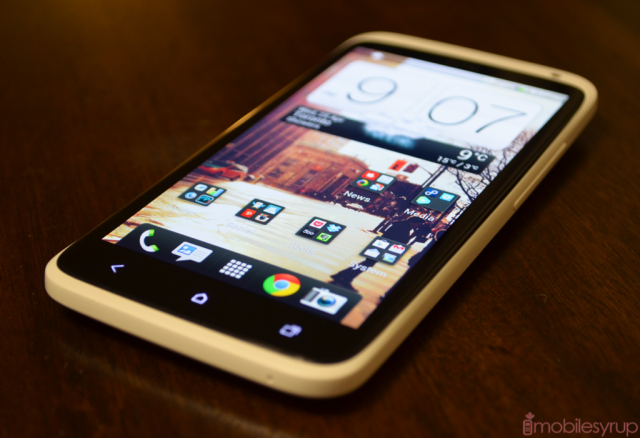
NUMBER FOUR – HTC One X
Though the HTC One X debuted in February and was released in Canada on Rogers in April, it still holds up today as one of the most stunning handsets I’ve ever used. Not only did HTC promise and deliver on improved build quality, screen clarity and software austerity, but the One X was the first carrier-released device to run Android 4.0 Ice Cream Sandwich, and the first consumer handset to sport Qualcomm’s ultra-fast Snapdragon S4 SoC.
Though the initial misgivings we had with the phone — poor battery life; hit-and-miss camera quality; questionable UI improvements — still hold true, the One X was a device that I continued to return to as newer phones came and went. Indeed, when TELUS released the grey One X this summer and then the One X+ in November, the company proved that they were laser-focused on taking a great product and improving on its fundamentals.
Unfortunately, HTC has been laid low, both in terms of market- and mindshare, by the marketing muscle of Samsung. There is no question that in many ways the One X was, and still is, a superior product to the Galaxy S III, but the Taiwanese company doesn’t have the budget to compete with the big players anymore. It’s also unfortunate that, though the One X was the first device to bring Ice Cream Sandwich to the market, it still hasn’t been upgraded to Jelly Bean weeks after the One X+, which came with Android 4.1.1 out of the box, found its way to consumers.
HTC’s “rebirth” in 2012 may not have made the splash with consumers it should have but it, along with the One S and One V, laid a solid foundation for the company’s future.
The HTC One X is available from Rogers in white and from TELUS in grey. Its sort-of-sequel, the One X+, is available exclusively from TELUS in black (and it’s beautiful).
Read more: HTC One X Review, HTC One X+ Review
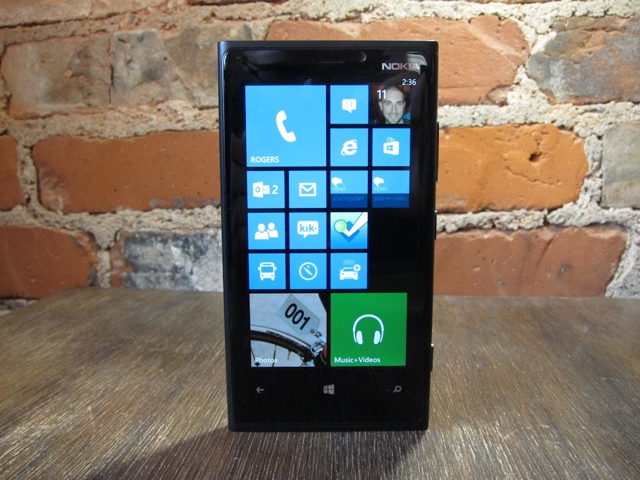
NUMBER FIVE – Nokia Lumia 920
I truly wish that this phone was higher on the list. In some ways, the Lumia 920 is one of the finest smartphones ever made; based on the design, build quality and sheer ambition, this ranks as high as any out there. Its PureView-enhanced camera with optical image stabilization would be enough by itself to sustain excitement for the device, but the gorgeous screen and truly wonderful Nokia-specific apps round out the experience.
But Nokia’s triumph is hobbled by Windows Phone’s murky future: lackluster app selection; a poor notification system; deprecated Exchange ActiveSync for Gmail; mediocre multitasking. The Lumia 920 has also had its share of personal issues including a contentious exclusivity period with Rogers and lack of colour options that have tempered its desirability. While Nokia and Rogers have always been closely tied — the carrier bravely released the N8 when no other North American carrier would touch Symbian — keeping the phone out of the hands of over 15 million Canadians was a poor decision.
Ultimately, the success of the Lumia 920 hinges on whether Microsoft can convince users to give up what they know in favour of a brave new world called Windows Phone. The OS is slowly becoming a true contender as brands build apps and users grow loyalty.
The Nokia Lumia 920 is available from Rogers.
Read More: Nokia Lumia 920 Review
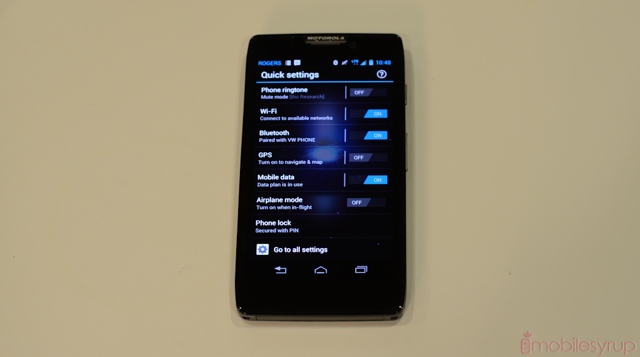
NUMBER SIX – Motorola RAZR HD LTE
It took many months before consumers saw a glimpse of what Motorola would look like post-Google. The company was acquired for an ungodly sum in early 2012, largely for its patents, but the fruits of that venture came to be in the release of the Motorola RAZR HD LTE.
A Rogers exclusive, Motorola took what it had learned from its parent company and incorporated many unique features of its own, culminating in one of the most enjoyable Android experiences of the year. That it arrived with Android 4.0.4 was disappointing, but between the superlative build quality, enormous battery, gorgeous AMOLED screen, excellent performance and subtle UI improvements, Motorola had a veritable hit on its hands.
If you’re looking for multi-day battery life without the added screen size of the Note II, this is really your only choice in the Android ecosystem. But for Motorola’s poor choice in camera modules, and the still-impending promise of a Jelly Bean update, this was one of the best Android devices of the year.
The Motorola RAZR HD LTE is available from Rogers. Its so-close-it-could-be-a-brother ATRIX HD LTE is available from Bell.
Read more: Motorola RAZR HD LTE Review
NUMBER SEVEN – Sony Xperia T
Last but not least, Sony has done some very interesting things in 2012 but, like its place in this list, they’ve always been one step behind. With the Xperia T, the newly-consolidated company has issued its best offensive play against Samsung et al., and while the device is plenty svelte and sufficiently fast, it launched too late in the year, and with no “hero” features, to make a sizeable impact.
As welcome as are Sony’s various value-added services like PlayMemories Online and Music Unlimited, they are not exclusive to Sony devices; and the refreshed Android interface, while attractive, is little more than head-turning. Nevertheless, the Xperia T provides a great camera experience and a superb retinue of first-party apps. It’s also the only OEM that has truly taken Android developers under its wing, and promises to do more in the coming year.
The Sony Xperia T is available from Rogers, Bell and MTS.
Read more: Sony Xperia T Review
—
Smartphones of the Year (Entry-level)
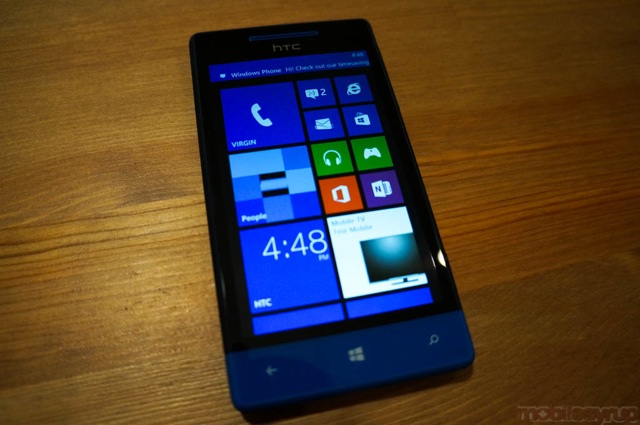
NUMBER ONE – Windows Phone 8S by HTC
If Windows Phone 8 seems to be languishing somewhat in the high-end space, it is ultra competitive in the entry-level. HTC has our top two entries this year as they’ve managed to combine beautifully-designed hardware with affordable outright pricing.
The 8S is a tiny powerhouse, sporting a gorgeous 4-inch WVGA display, a dual-core Snapdragon S4 processor and all the latest fixin’s from HTC and Microsoft. Coming in under $300 is a coup for consumers and carriers alike.
This thing is going to sell like crazy.
The Windows Phone 8S by HTC is available from Virgin Mobile.
Read more: Windows Phone 8S by HTC Review
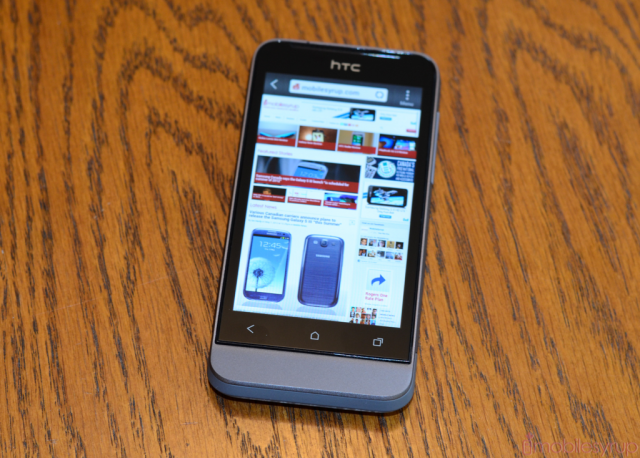
NUMBER TWO – HTC One V
An oldie but a goodie: the HTC One V has aged more than gracefully. It still sports some of the best construction in a sub-$200 phone (it’s available for $150 outright from Koodo) and comes with Android 4.0 out of the box. Sure, it won’t be updated past ICS, nor will it live on past 2012, but you can’t go wrong with this Legend successor.
The HTC One V is available from Koodo, TELUS and Bell.
Read more: HTC One V Review

NUMBER THREE – Huawei Ascend P1
While it doesn’t have the microscopic outright price of the above two devices, Huawei’s first decent contribution to the Android rat race was an impressive dual-core device. Sporting both stock Android and Huawei’s own 3D launcher, the phone contains decent enough specs to compete with many modern high-end phones and a slim enough form factor to forgive the less-than-impressive battery life.
The Huawei Ascend P1 is available from WIND Mobile.
Read more: Huawei Ascend P1 Review
—
Well, that wraps it up for another year. Remember, these are our favourites and not a definitive list by any means. There were phones we left out — the HTC One S, for example, deserves a nod — and ones we wished were just a little bit better, like the Sony Xperia ion.
It’s no coincidence that the list heavily favours phones released towards the end of the year, either. Progress is swift in the mobile industry, and companies are expected to iterate quickly to keep up with the competition. Ultimately, it’s the consumer that benefits most from these quick cycles, but users can also feel overwhelmed and frustrated that their phones are so quickly out of date.
In many ways, 2012 was the first year that specs mattered less than features; all phones, regardless of make, model or operating system, operate contain more processing power than most computers did five years ago. Its no small thing that we can play games, surf the web, take notes, draw, screenshot, append, notify and communicate on a device the size of ones’ hand. It’s important to remember that, though they are dear to us, and always near our person, they are still made of metal, plastic and glass, and our allegiance to one brand or one operating system is as fluid as the industry itself. Remember that the next time you flame someone for disagreeing with your choice of handset.

